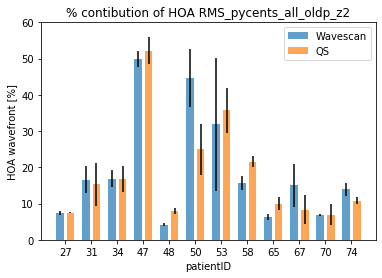Assessment of wavefront measurements from a low-cost, portable, aberrometry-based autorefractor

| AUTHORS | |
| JOURNAL | Investigative Ophthalmology & Visual Science June 2020, Vol.61, (ARVO 2020) |
|
Purpose : A pilot study to assess the measurement of both low- and high-order ocular aberrations from a low-cost portable wavefront aberrometer.
Methods : A total of 41 patients (age 53 ± 17 years) were recruited and underwent non-cycloplegic measurements on a desktop wavefront aberrometer (Wavescan) and a portable wavefront autorefractor (QuickSee). Each eye was measured 3 times under consistent lighting condition. From the Wavescan, we recorded refraction, pupil size, and Zernike coefficients for each eye sequentially. QuickSee is a low-cost, hand-held, open-view autorefractor based on aberrometry. From the QuickSee, we recorded Shack-Hartmann spot patterns for 10 seconds from both eyes at the same time. In eyes where the pupil was fully captured on the QuickSee sensor, the resulting spot diagrams were post-processed with a custom-developed algorithm to calculate Zernike coefficients representing low- and high-order aberrations (HOAs). Zernike coefficients up to the 6th order were analyzed in both devices. Manifest refraction was recorded as the prescription within 6 months of the visit to the eye clinic (Johns Hopkins Green Spring Station). Bland-Altman plots, intraclass correlation coefficients (ICC), and paired t-tests were used for statistical analysis. Results : The refraction agreement was analyzed on the 64 eyes that completed the protocol. Both devices demonstrated good agreement with each other and with manifest refraction. The QuickSee measured 84%, 94%, and 98% and the Wavescan measured 70%, 97%, and 98% of all eyes within 0.5 D of M, J0, and J45 vectors from manifest refraction respectively. Only the 19 of these eyes had sufficient alignment of the pupil on the sensor for HOA analysis. Among these eyes, the total HOA wavefront error and the percentage contribution of the HOA to the total wavefront error showed good inter-device correlation (ICC3=0.79 and 0.91, respectively). Bland-Altman analysis of the total HOA wavefront error (RMS) showed a mean difference of 0.009 (SD: 0.090) µm. The mean differences for the total HOA wavefront errors measured by the QuickSee and Wavescan were not statistically significant (p=0.67). Conclusions : The collective HOA measurements from a portable, low-cost autorefractor showed no significant difference from the commercial desktop wavefront aberrometer, and the contribution of HOA to the total wavefront error showed good inter-device reliability.
|
|
| LINK | here |



